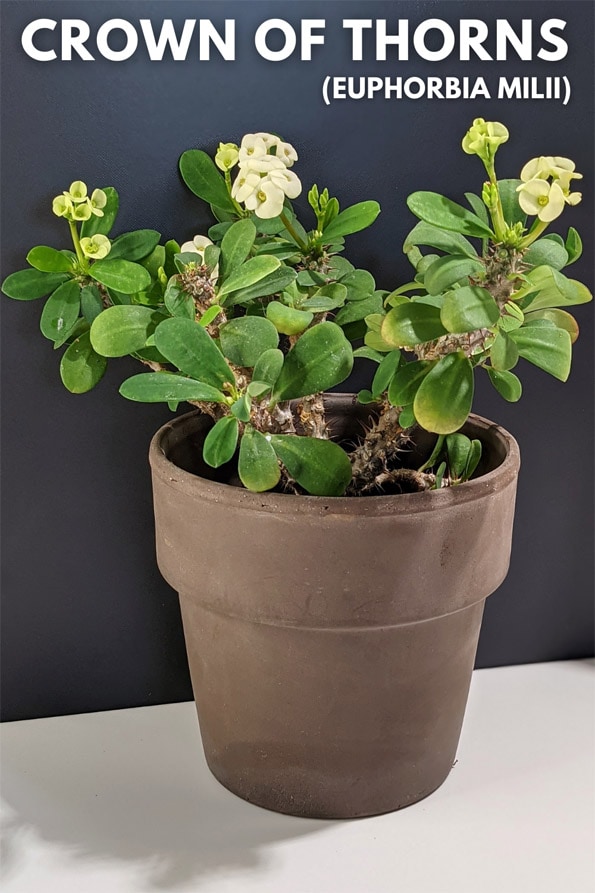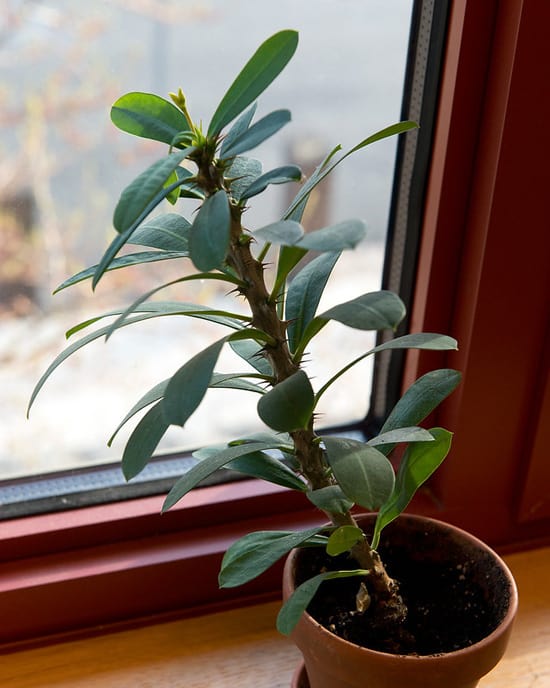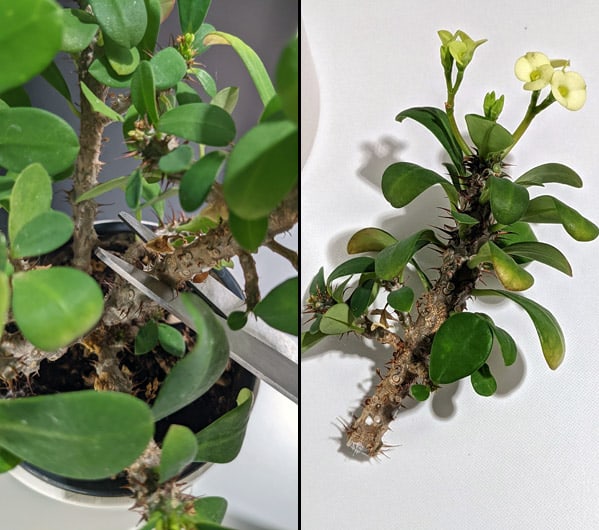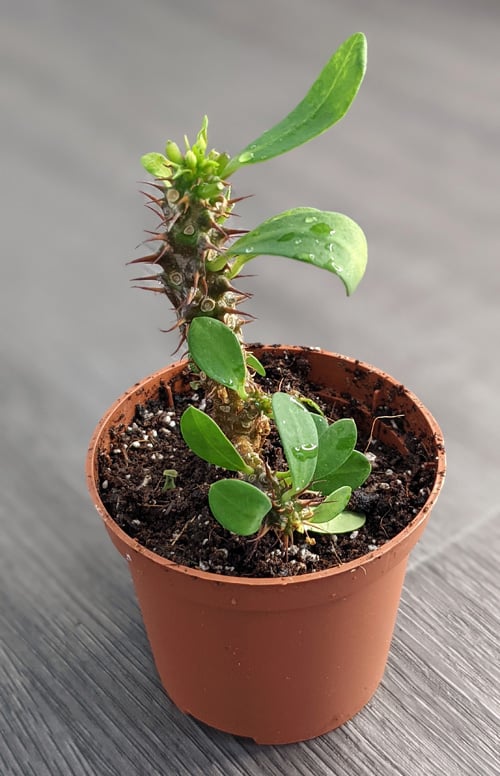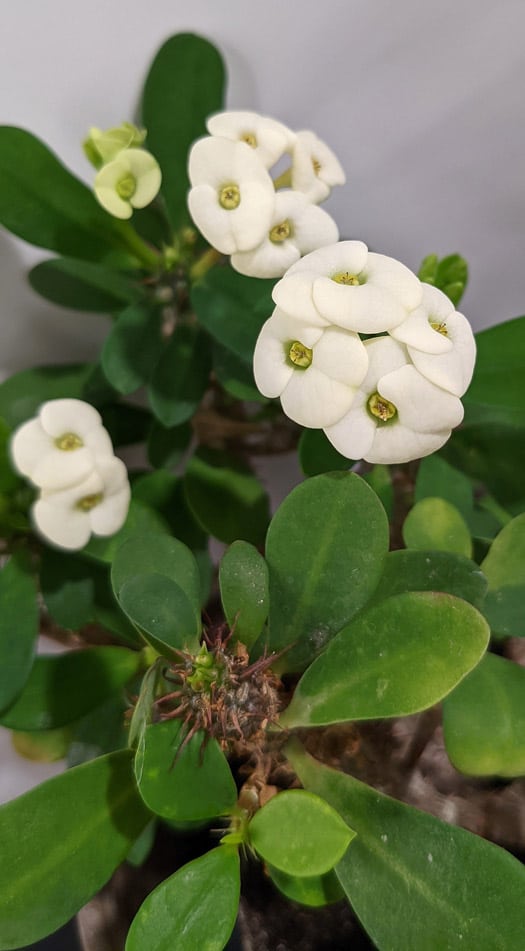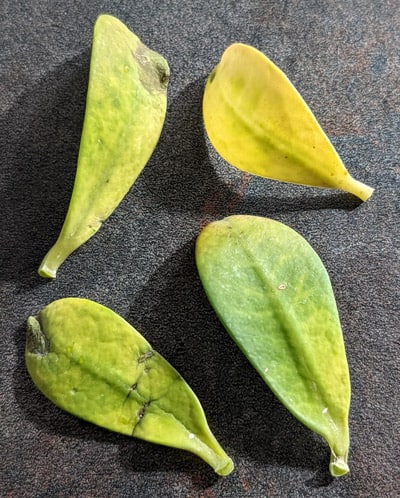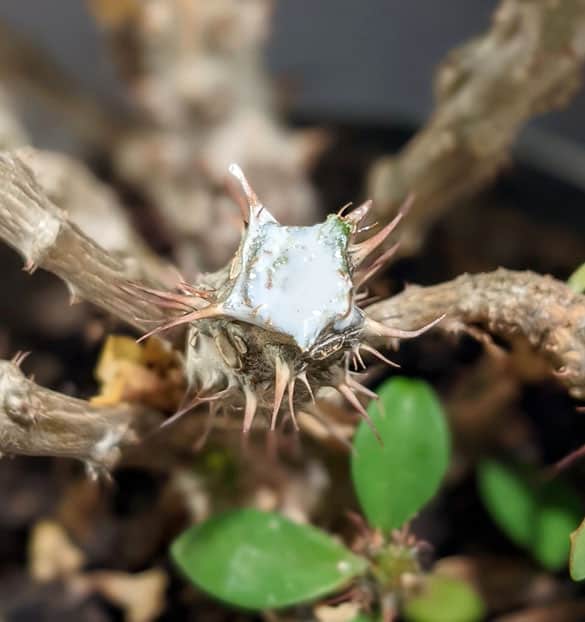Euphorbia milii or the Crown of Thorns plant grows as an evergreen shrub in its native Madagascar. However, for most of us, we will often know it better as a traditional houseplant that's been grown indoors for decades.
They have an easy going nature and if you can follow the straightforward care instructions, you could have one in bloom almost all year round.
The Crown of Thorns is a euphorbia species often grown as an easy-care plant.
How do you pronounce Euphorbia milii correctly? Say:
yew-FOR-Bee-ah MIL-ee-eye
It has several outstanding qualities, such as being impervious to most pests and insects and like many succulent plants, it can deal with sporadic watering and some poor care.
New growth from various points of the main stems are quite forthcoming and it's easy to propagate new plants. All of these traits mean it's not a difficult houseplant to own or keep looking good for years.
Dealing with the sap
If you damage any part of the plant, you can expect milky sap to appear. Small amounts will dry out and callous over, but if there is a lot, just run it under cold water for 30 seconds and it will stop.
The thorns at first glance might deter some people, but in reality they're not very sharp at all. They're fairly soft to the touch, and they're generally not a problem unless you grab at them forcefully. The plant does contain the familiar latex sap found in many euphorbia plants that can be irritating if you get it on skin or anywhere near your eyes.
There are several varieties out there, although the range on offer is normally limited and most plants being sold aren't labeled.
Plants being sold as Euphorbia milii or Euphorbia splendens are in reality most likely the same. The plant was introduced to the Western World in France by Pierre Milius in 1821. His surname was used to give the Species name ("milii").
At some point, some sellers renamed it Euphorbia splendens (although I've not been able to find why out) essentially though they're the same plant.
Did you know?
The common name "Crown of Thorns" or "Christ Plant" comes from the original plants with red flowers. They were thought to resemble the crown thorn Jesus Christ had to wear during his crucification.
Over many years there have been some cultivars and hybridising which has resulted in slightly different growth habits, but none of the plants look vastly different from one another. I have seen one with variegated leaves, and with the popularity of variegation on houseplants at the moment this could become pretty sought after.
The main result from all this work is the colouring of the flowers. The originals were red, but now there is more choice from the familiar reds, to creamy white or yellow. There are even blooms with multiple colourings and attractive hues.

Hi, I'm Tom!
If you're like me and enjoy the challenge of growing houseplants and getting them to thrive, then Ourhouseplants can help. This website shares my knowledge and years of growing plants and provides (hopefully) helpful advice on properly caring for your indoor plant friends.
The Crown of Thorns is a sun loving houseplant. They thrive in full sunshine and will struggle in shade.
A few hours of sunlight as a minimum will give you a good looking and healthy plant with lots of flowers. If direct sun can't be provided, they're going to need the brightest spot you have.
I've seen many care guides saying they can cope with low light, but in my experience this just isn't the case. If grown in low light they end up looking ugly and ragged, small leaves, minimal to no blooms and lots of visible stem which just isn't attractive (to me at least).
If you can, grow it in a sunny window for best results - Photo by Plant Image Library
With their cacti and succulent like qualities, most Euphorbia can cope with some drought and the Euphorbia milii is no different. But that's not what they really want. They love a thorough drenching when the potting mix has almost fully dried out.
When it's time to water in the late Spring, Summer and early Fall, do give them a good watering. Just make sure you have drainage holes in the pot so any excess water can drain away.
Root rot and damage to the stems in contact with the soil can occur if the potting mix is kept constantly wet, so some drying out is essential.
This is even more important in winter, especially if the temperatures are cooler. As excess moisture will encourage fungal and bacterial diseases. So make sure that you let the plant dry out even more, and you won't need to drench the potting mix as much. Just enough to dampen it is plenty at this point in the year.
The Crown of Thorns will cope well with low or medium humidity levels.
They're not overly heavy feeders, but all that blooming does require some feed. Feeding every couple of months with an all purpose liquid fertilizer or one designed for cacti and succulents should be enough.
You can also add in some slow release fertiliser granules when you repot or propagate new plants and this will normally keep your plant well fed for the following six months.
The Crown of Thorns is native to warm climates and so likes heat and is not hardy. This means that they don't like cold temperatures, so try to grow it somewhere with a temperature consistently above 10°C (50°F) all year round.
It takes a while for the roots of these houseplants to fill their pots, so you won't need to repot it frequently. Once every couple of years is usually enough, but you can of course do it earlier if the roots are very congested and a high number are growing out of the container's drainage holes.
When the roots "escape" out of the bottom it's usually a sign it's run out of space and is in search of a new source of potting medium.
A free draining light potting mix is pretty much essential. They're not bog plants and will suffer if the roots are constantly saturated with water. Make sure your pot has a drainage hole (or several) at the bottom to let excess water drain away.
A ready made succulent or cacti mix is ideal, but you can also just use regular potting soil and add in some perlite or gravel to "open it up" all of which will help with the drainage. They can also be grown in sandy soil if you add in horticultural sharp sand to your everyday garden compost.
Although they produce many flowers, very few will produce seeds that you can sow and grow.
Therefore it's much easier to take tip cuttings or stem cuttings to propagate replacement or brand new plants. A new plant grown this way will have the same colour flowers as the parent once it's reached maturity.
Crown of Thorns plants can be easily propagated. Cut off a healthy stem, remove some of the leaves and all the flowers. Wait a few days and then it'll be ready to plant up.
To get started all you need to do is find a stem that you want to propagate. I like to prune my plant into shape from time to time and keep it fairly upright, rather than spreading. This means any stems heading out towards the sides are perfect candidates.
Just cut the stem and you have the cutting. You need to remove around half of the leaves and any flowers growing on it. This is so you force the cutting to focus its time and energy on producing new roots, and not having too many leaves for the cutting to support really helps with this.
When you do all of this cutting and cleaning up, the damaged and cut edges will be oozing the familiar white sap. Dab it with a paper towel or absorbent cloth. Alternatively, you can just run this under a cold tap for 30 seconds and it should stop.
Sometimes cuttings planted in the middle of a pot will fail. If this keeps happening to you, then you might have better success if you plant it at the very edge of the pot instead. Might sound weird, but it does work.
Leave the cutting to dry for several days. The bottom will callous over and you could well lose a few of the remaining leaves. All normal and all okay.
The final step is to fill a pot with a similar potting mix that the parent plant was growing in, then pot up the cutting into it. Water it in before moving to a bright and warm place. Keep it out of direct sunlight and aim to keep the soil just moist for a few months. After this time you should have an established cutting with a new root system.
Here's a 20 second video of me doing all the steps described above (click image to play).
If it gets warmth, sun and proper watering, the growth rate is pretty steady for most of the year, it's still considered a slow grower compared to other houseplants. If you get any of these things wrong your plant will hardly grow at all.
It's usual to buy these plants small. They have petite leaves and small flowers, but the plants can get quite a bit bigger over time. The stems get larger and thicker, and the leaves and flowers get bigger too. So a mature plant can make a big impact.
In their native habitat they can grow up to 6 feet (180cm) tall, but inside you can expect a more modest height of 2 foot (60cm) after many years.
They can spread out in unusual directions though, and this can be controlled to your liking by pruning.
The blooms are one of the main advantages of this houseplant. With proper care you can have them being produced on a continuous basis all year round.
Like the related Poinsettia plant, the actual flowers themselves are small and a unremarkable creamy light green. It's the colorful bracts that surround the flowers that catch your eye.
These bracts will normally be red, pink or yellow. Some bicolored varieties stand out even more, but they're not as popular (yet!).
If given enough sunlight and grown in a warm location, blooms will form on the thick stems all year round.
As touched on earlier the stems are coated in thorns, although they're not excessively sharp they can still hurt if you or a pet gets to close. If anything manages to get past these thorns, then all plant parts, including the leaves, will "bleed" an irritating latex sap if they're damaged.
Did you know?
It's normal to see the latex sap whenever the plant is damaged and this has two main benefits.
Pest Resistance -
The taste is very bitter and the skin irritation it causes will repel animals that try to eat it, whereas the toxicity and stickiness deter insects.
Healing -
As the sap dries, it'll form a healing "scab" over the wound, which helps prevent infection.
This sap is not likely to cause any long lasting effects on people, but it can be more toxic to animals, including cats and dogs. Therefore, this houseplant is not safe around pets that take an interest in your indoor plants.
General Housekeeping
The blooms, while almost constantly being produced, do still fade and expire. Some leaves also go brown and crispy. The plant tends not to let go of these naturally and they sort of hang onto the plant or get caught on the thorny stems making it look unattractive.
The Solution
Invest in a pair of tweezers and remove the faded blooms and leaves every couple of months to keep your plant looking pristine.
Pruning
Growth shoots can form anywhere on the stems and can start growing out in less than ideal directions.
Bonus Tip
Any stems you "prune" can be used as stem cuttings for propagation.
The Solution
Prune any stems or "branches" that take away from the overall look you're going for.
For example if the new growth starts to give a spreading habit, but you want an " upright" look, trim off the side facing stems. Just take care of the sap which will typically pour out of the plant whenever you cut into it.
No Flowers
It's common to have the Crown of Thorns throwing out flowers for months and months. Each bloom will only last a few weeks but new ones are regularly produced. So if you have long spells of nothing then something is wrong. The most probable reasons are outlined below.
Pests
Thrips (Thunderflies), Mealy Bugs, Spider Mites and Scale Insects are all possible pests that could end up living on your plants. However in my experience, they rarely attract pests at all. I suspect the latex sap found within all parts of the plant deter them naturally.
However if you do spot these pests I've linked to treatment options in the last paragraph (also please do drop a message in the comments below and let me know, as I'd be interested to see if anyone does have issues).
No Growth
Too little light, in need of repotting and lack of nutrients in the soil would all be reasons your plant's not growing. Good bright light, a decent sized pot and semi regular feeding are all needed for new growth.
Yellow Leaves
This can happen because of overwatering, it can also occur if the temperature is too low. If the yellowing is only slight, as shown on some of the leaves in the photo, then this could be caused by a mineral deficiency.
The stems of this plant will not be covered in leaves as it ages, so it's natural for the lower leaves to go yellow and drop off over time.
Although Euphorbia milii is an evergreen plant, yellow leaves will still occur from time to time.
Root Rot
Although everything above the surface is well protected, the roots in the soil are vulnerable to root rot which can encourage fungal diseases.
During the growing months these plants do like a heavy complete watering, after which the potting soil would be pretty damp. But if you're correctly growing it in a bright sunny and warm spot somewhere, then this is perfectly fine. The potting mix will quickly start to dry out and you'll avoid things like root rot from setting in.
If the potting mix takes too long to dry out for whatever reason, perhaps because the temperature is low, or the growing medium isn't free draining then rot can set in. If this happens it could be time to remove some of the upper stems and try and propagate replacement plants.
Regular readers will already know I kept away from Euphorbia plants for many years. The thorns, and "look" of these plants in general tended not to appeal to me.
I gave the African Milk Tree (Euphorbia Trigona) a chance a few years back and quickly fell in love with it. So easy to care for with some speedy growing, it was is a win-win in my eyes. And from that positive experience I decided to try a few more Euphorbias, including the Crown of Thorns.
The spiny stems are protected by the thorns but if it gets damaged, the cut end will leak. Wear gloves to be extra safe.
The sap and thorns still worried me a little, but the reality is that you can put it in a sunny spot out of the way and there is no real reason you'd have to come into contact with the negative elements on a day to day basis.
Initially I brought two plants at the same time, one with white flowers (pictured throughout this article) and another with red flowers. There was a hairy moment early on when I kept watering them without letting them dry out and the red one quickly went downhill and turned into a rotten mess.
I quickly learned the golden rule to water well and then wait until it's almost completely dry before watering again. My second plant now sits in a South - East facing window so gets the mid morning sunlight on its leaves which it seems to like. Since then I think it's been in bloom almost constantly for years.
All in all it's not my favorite houseplant I've ever owned, but it's undoubtedly very undemanding and yet still sits there happily making a good impression. Another steady and reliable plant I'd recommend for beginners and experienced collectors alike.
(Gallery) Photo of the tall plant Puddin Tain
(Gallery) Photo of the thorny stem with red flowers by Wayne S. Grazio
(Article / Gallery) Photo of the Euphorbia milii in the window by Plant Image Library
